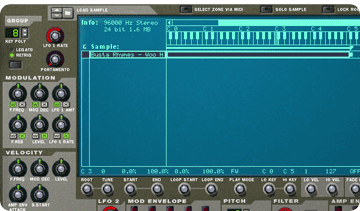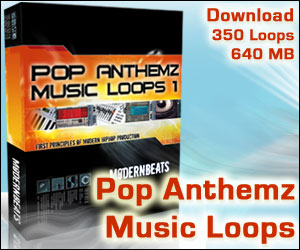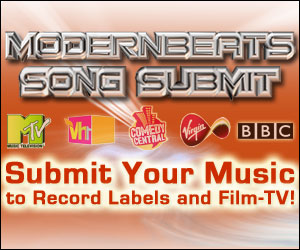Billboard’s Hidden Treasures
Everyone listens to what’s hittin’ the top of Billboard. Hundreds of those songs get copied, remixed, re-invented, and imitated by hundreds of artists. How many times have you heard a novice producer’s beat and thought “hey, I recognize that”? Really, there’s nothing wrong with learning or sampling from melodies that are already popular, but what if - instead of remixing what everyone is hearing in popular songs - you remixed what everyone isn’t hearing? Don’t know what we’re gettin’ at? Let us enlighten you. Follow these steps:
1) Choose your songs:
Pick a list of your favorite Billboard hits. Any hits will do, but for our purposes, we suggest songs with long, sustained bass notes rather than quick, staccato bass lines. Once you’ve chosen your songs, you have to make sure you can trigger and play them as a single file using a keyboard, and that may require converting their format. We’ll explain that next.
2) Convert your songs to a sampler-compatible format:
 If you’ve purchased an MP3 online, it will be incompatible with a sampler like Reason’s NNXT, so you’ll have to use music software such as an .MP3 to .WAV converter program to convert the MP3 it into a wave file. Other music software, such as FL Studio, can import MP3s directly into on-board sampler(s), allowing you to skip this step and streamline the process significantly. We’ve converted a part of “Woo Ha” by BustaRhymes to a 24-bit wave file at 96kHz. However, since this is mainly an exercise in idea-creation as opposed to optimizing audio recording quality, feel free to sample at a smaller bit depth and resolution. Above, we’ve loaded the song’s file into Propellerhead’s advanced software sampler NNXT included with Reason in preparation for step 3.
If you’ve purchased an MP3 online, it will be incompatible with a sampler like Reason’s NNXT, so you’ll have to use music software such as an .MP3 to .WAV converter program to convert the MP3 it into a wave file. Other music software, such as FL Studio, can import MP3s directly into on-board sampler(s), allowing you to skip this step and streamline the process significantly. We’ve converted a part of “Woo Ha” by BustaRhymes to a 24-bit wave file at 96kHz. However, since this is mainly an exercise in idea-creation as opposed to optimizing audio recording quality, feel free to sample at a smaller bit depth and resolution. Above, we’ve loaded the song’s file into Propellerhead’s advanced software sampler NNXT included with Reason in preparation for step 3.
3) Trigger, listen and learn:
Now for the fun part. Once you’ve loaded a song file into your software sampler of choice, it’s now time to trigger the song file at different pitches using your keyboard midi controller. Usually, you will find the most musical results when triggering the song file at higher registers, where lots of strange transformations will occur upon playback. For example, the bass line progression will change into a tenor melody; that’s simple
 enough. Yet, something even more surprising happens with snare drum rolls: as a song is triggered, as a sampled file, at higher and higher pitches on the keyboard, snare drum rolls and fills start to form bass frequencies. “What?” you say. Here’s how:
enough. Yet, something even more surprising happens with snare drum rolls: as a song is triggered, as a sampled file, at higher and higher pitches on the keyboard, snare drum rolls and fills start to form bass frequencies. “What?” you say. Here’s how:
Let’s say you’re listening to an up-tempo club song that you’ve converted and loaded, as we’ve converted and loaded Woo Ha, into Reason’s NNXT sampler. The song tempo is 120 bpm. There’s a 1-bar, 16th-note roll at the end of each verse and hook. At 120 bpm, a 16th note drum roll has a frequency of 32Hz (since Hz represents beats or oscillations per second.) Triggering the song an octave higher than its original pitch speeds everything in it up by a factor of two, increasing the drum roll to 64Hz. Transposing four octaves higher brings the frequency of that Sonor drum roll to 512 Hz. Now the ear has stopped perceiving the drum roll as a rhythm, and instead perceives it as a frequency: C2, in fact. Now, think about the structure of the original song… What used to be a 16th note roll at the end of the verses and hooks is now a gritty buzzing C bass note that lasts just over a half-second at about every other 5 seconds in the sampled song (5 seconds is how long those verses and hooks last now that they’ve been speeded up.) With a little file manipulation, new ideas for production can blossom. Plus, depending on the mix for the song you’ve chosen to sample and test, the results could prove pure dynamite, lending several unthought-of production tricks and ideas.
4) Appropriate at will!
OK, you’ve made it through a half-dozen songs, and finally one of ‘em has delivered on our promise, you’re loving what you’re hearing. Now what? Though you can’t remix those samples without paying for them, you can benefit from the hidden melodies and accelerated rhythms inherent within. There are two ways to go about creating your own, fresh versions of these hidden musical treasures. If you’re looking to copy the unique timbres and fresh effects that result from speeding up your chosen song, you’ll need to reproduce the song using your own music production gear, then speed up your reproduction. So, for example, if you like the sound of percussive elements at an extremely high speed, or - like in the above example - at speeds that are heard as tuned frequencies instead of rhythms - you’ll have to copy those percussion tracks and transpose accordingly. If, on the other hand, you’re copying a slow bassline that became a fast tenor melody when you re-pitched it in the sampler, the process is much easier. Copy that fast tenor melody using an instrument you’re familiar with, simple as that.
Either way, this is a productive exercise in idea generation and creative re-interpretation. Now you realize how Billboard hits can offer you far more than simple listening enjoyment, but enable you to spawn new production ideas once you apply a little sample manipulation to them. It’s like remixing, but with the added experimental twist of re-pitching all your source material. And don’t knock it ’till you try it. The crazier this sounds to you, the more likely you are to benefit from it.







 GET 20% OFF COUPON INSTANTLY W/ SIGN-UP!
GET 20% OFF COUPON INSTANTLY W/ SIGN-UP!
 Check Out Hot Artists & Music Producers discovered through Song Submit!
Check Out Hot Artists & Music Producers discovered through Song Submit!



Submit Music Production Questions or Comments
Submit your music production related questions or comments below...
Get 10 Free Music Production Tips!
 GET 20% OFF COUPON INSTANTLY W/ SIGN-UP!
GET 20% OFF COUPON INSTANTLY W/ SIGN-UP!
Sign-up Now & Get 10 Free Music Tips!